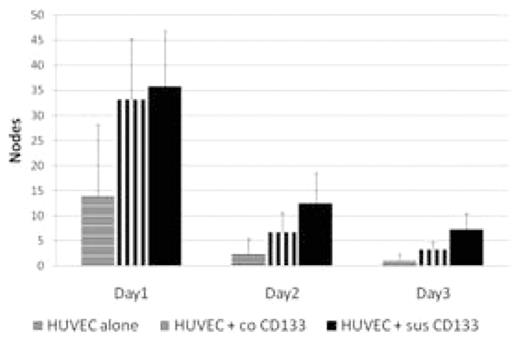Abstract
The revascularization of patients with ischemic conditions is a major obstacle in medicine. Umbilical cord blood (UCB) holds revascularization potential as a source of stem cells and progenitor cells, particularly those designated by the surface markers CD133 and CD34. Human umbilical vein endothelial cells (HUVEC) have been used to study the formation of angiogenic structures. These structures result in networks characterized by nodes with two or more branch points. Our hypothesis is that the effector cells (UCB-derived CD133/34 pos cells) have a proangiogenic effect on the growth of HUVEC by a paracrine mechanism rather than integration into the network of angiogenic structures.
When cultured on the gelatinous protein matrix Growth Factor Reduced Matrigel (GFR MG), HUVEC form a network of branching structures. Matrigel with reduced growth factors was used because we wanted to assess the role of growth factors released by effector cells. Growth factors in GFR MG include bFGF (0–0.1 pg/mL), EGF (<0.5 ng/mL), IGF-1 (5 ng/mL), PDGF (<5 pg/mL), NGF (<0.2 ng/mL), and TGF-b (1.7 ng/mL). A co-culture assay of HUVEC and CD133/34 pos cells on GFR MG allowed the measurement of the kinetics, magnitude, and persistence of structure growth. Because we wanted to mimic an ischemic bed, experiments were performed at 1% O2 in a PRO OX chamber (BioSpherix). To determine if cell-to-cell contact is required for augmentation of angiogenesis, Transwell experiments with CD133/34 pos cells suspended above HUVEC cultured on Matrigel were conducted. The pore size of 0.3 μm in the Tranwells did not permit cell penetration. In addition, levels of growth factors were measured by a Luminex assay for the factors hFGF, hHGF, hINF-g, hMIP-1a, hMIP-1a, hIL-8, hRANTES, hTNF-a, and hVEGF. Cells were cultured at 2 × 106 cells/mL for 24 hrs and media was collected for analysis.
The number of branch points or nodes (a quantitative measurement of angiogenesis), was greater when magnetically-selected and fluorescence-activated cell sorted UCB-derived CD133/34 positive (pos) cells are added to the HUVEC culture on Matrigel than when HUVEC were cultured alone. When the CD133 negative (neg) cells from the cord blood are cultured with HUVEC, the number of nodes also increased at the first time at 16 ± 2 hours. The presence of both UCB-derived CD133/34 pos and CD133/34 neg cells also causes the nodes to persist longer than HUVECs alone, while the CD133/34 neg fraction allows the structures to persist to a greater degree than the CD133/34 pos fraction when followed for three days (Table).
| . | Day 1 . | Day 2 . | Day 3 . | |||
|---|---|---|---|---|---|---|
| . | Node # . | % Total . | Node # . | % Total . | Node # . | % Total . |
| HUVEC alone | 11.6 ± 4.9 | 100 | 1.3 ± 1.15 | 9.2 | 0.33 ± 0.58 | 2.2 |
| HUVEC + HSC CD133/34 pos | 17.3 ± 9.2 | 100 | 6.3 ± 4.5 | 35.3 | 4.7 ± 5.5 | 21.4 |
| HUVEC + HSC CD133/34 neg | 34 ± 13.2 | 100 | 19.7 ± 2.5 | 61.6 | 10 ± 3.6 | 29.8 |
| . | Day 1 . | Day 2 . | Day 3 . | |||
|---|---|---|---|---|---|---|
| . | Node # . | % Total . | Node # . | % Total . | Node # . | % Total . |
| HUVEC alone | 11.6 ± 4.9 | 100 | 1.3 ± 1.15 | 9.2 | 0.33 ± 0.58 | 2.2 |
| HUVEC + HSC CD133/34 pos | 17.3 ± 9.2 | 100 | 6.3 ± 4.5 | 35.3 | 4.7 ± 5.5 | 21.4 |
| HUVEC + HSC CD133/34 neg | 34 ± 13.2 | 100 | 19.7 ± 2.5 | 61.6 | 10 ± 3.6 | 29.8 |
Table: “Node #” refers to the mean node count for each day and culture type. “% Total” refers to the percentage of nodes remaining each day after the first count occurring on Day 1. Thus, all Day 1 totals are 100%.
Importantly, in Transwell experiments, the number of nodes formed did not differ between co-cultures of HUVEC and CD133/34 pos cells compared to those with only HUVEC in the bottom chambers. Direct cell-to-cell contact between HUVEC and CD133 pos does not appear to be required for augmentation to occur but involves released factor (see Figure 1-Transwell Nodes).
Two pro-angiogenic factors that are released by UCB-derived cells were identified from the Luminex assay that may be key players in the augmentation of the angiogenic structures—IL-8 and RANTES. Other measured factors were not produced at levels over the sensitivity of the assay. Measured cytokine concentrations for IL-8 were 3332 ± 498 pg/mL for CB CD133/34 pos cells and 7257 ± 1562 pg/mL for CB MNC. RANTES concentrations were 695 ± 183 pg/mL for CB CD133/34 pos cells and 1310 ± 75 pg/mL for CB MNC. Results of these assays demonstrate that the formation of angiogenic structures in a co-culture assay with HUVEC and UCB-derived cells is augmented by the effector cells releasing key factors, including IL-8 and RANTES. Although the CD133/34 neg (MNC) population holds potential in its greater cytokines production and greater ability to augment HUVEC structure formation, selected CD133/34 pos cells, known to illicit less immune responses, provide a significant level of augmentation of HUVEC structures.
Disclosures: No relevant conflicts of interest to declare.
Author notes
Corresponding author


This feature is available to Subscribers Only
Sign In or Create an Account Close Modal